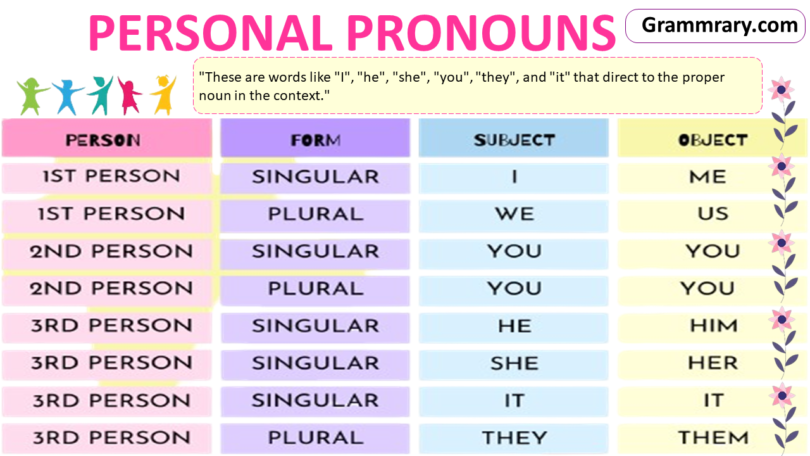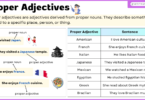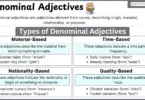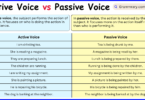Do you know the savior of content, from being monotonous or repetitive? You do! These are PERSONAL PRONOUNS. Generally, Pronouns serve this purpose. They replace the nouns in the text, being the “subject” of the sentence. Whereas, personal pronouns replace the proper nouns. Learning What is a personal pronoun, the Usage of Personal Pronouns, the Personal Pronouns List and Exercise play a key role to excel in Grammar. Let’s start!
What Are Personal Pronouns?
Short words use to replace Proper Nouns in the content to avoid their repetition. It saves the content from being wordy, monotonous, and repetitive.
Definition of a Personal Pronoun:
Pronoun Definition: “These are words like “I”, “he”, “she”, “you”, “they”, and “it” that direct to the proper noun in the context.”
Personal Pronoun Examples:
Following are the examples of Personal Pronouns.
- I
- Me
- You
- We
- Us
- He
- Him
- She
- He
- They
- Them
- It
Personal Pronoun Example Sentences:
These are the personal pronouns Sentences.
- I am going to the market to buy clothes.
- She is going to university.
- He is completing his assignment.
- She is baking a cake.
- They are going to picnic.
Types of Personal Pronouns:
These are:
- First-person pronoun
- Second-person pronoun
- Third-person pronouns
They are used in two forms:
- Singular Personal Pronouns
- Plural Personal Pronouns
| Person | Singular | Plural | ||
| Subject Pronouns | Object Pronouns | Subject Pronouns | Object Pronouns | |
| First Person | I | Me | We | Us |
| Second Person | You | You | You | You |
| Third Person | He She They It | Him Her Them It | They | Them |
Correct Usage of Personal Pronouns:
There are Four factors to ensure the correct use. These are:
- Person (first, second, or third)
- Gender (masculine, feminine, neuter, or epicene)
- Number (singular or plural)
- Case (subject, object, possessive, or reflexive)
Person
The Personal pronoun is named as it indicates an individual.
First-person pronouns
- It refers to the author, the person who is speaking or writing.
| Subject | Object | Possessive | Reflexive | |
|---|---|---|---|---|
| Singular | I | me | mine | myself |
| Plural | we | us | ours | ourselves |
Second-person pronouns
These refer to the person, the writer or speaker is talking about.
| Subject | Object | Possessive | Reflexive | |
|---|---|---|---|---|
| Singular | you | you | yours | yourself |
| Plural | you | you | yours | yourselves |
Third-person pronouns
The third-person pronoun can refer to any other individual or thing.
| Category | Singular/Plural | Subject | Object | Possessive | Reflexive |
|---|---|---|---|---|---|
| Masculine | Singular | he | him | his | himself |
| Feminine | Singular | she | her | hers | herself |
| Neuter | Singular | it | it | its | itself |
| Gender-neutral | Singular | they | them | theirs | themselves |
| Plural | Plural | they | them | theirs | themselves |
Number
There are singular and plural personal pronouns based on the number of individuals or things it refers to.
- Singular pronoun: It involves only one individual or thing.
- Plural pronoun: It involves two or more individuals or things.
Gender
Here is the right way to choose, based on gender.
Masculine pronouns refer to men and boys. These are pronouns for male gender or pronouns for a man. Below is the male pronouns list.
| Subject Pronoun | Object Pronoun | Possessive Pronoun | Reflexive Pronoun |
|---|---|---|---|
| He | Him | His | Himself |
Feminine pronouns indicate females, women, and girls. Here is a female pronouns list.
| Subject Pronoun | Object Pronoun | Possessive Pronoun | Reflexive Pronoun |
|---|---|---|---|
| She | Her | Her | Herself |
Gender-neutral pronouns are used when you aren’t sure about the gender, or it is not required to specify gender in context.
| Subject Pronouns | Object Pronoun | Possessive Pronoun | Reflexive Pronoun |
|---|---|---|---|
| I | Me | Her | Herself |
| You | You | Yours | Yourself |
| It | It | Mine | Myself |
| We | Us | Us | Ourselves |
| They | Them | Theirs | Themselves |
Neuter pronouns describe non-human things like animals, places objects, and concepts.
| Subject Pronoun | Object Pronoun | Possessive Pronoun | Reflexive Pronoun |
|---|---|---|---|
| It | It | It | Itself |
Case
It is the role pronouns play in sentences. It can be:
- Subject pronouns (person or thing that performs the action)
- Object pronouns (Person or thing on which action is performed.)
- Possessive pronouns (Indicates the ownership)
- Reflexive pronouns (Pronouns used in the place of object pronouns)

Personal Pronouns
Personal Pronouns List:
Here is the list of personal pronouns in English.
First-Person Singular:
- I
- Me
- My
- Mine
- Myself
Second-Person Singular:
- You
- Your
- Yours
- Yourself
Third-Person Singular Masculine:
- He
- Him
- His
- Himself
The Third-Person Singular Feminine:
- He
- Her
- Herself
Third-Person Singular Neutral:
- It
- Its
- Itself
First-Person Plural:
- We
- Us
- Our
- Ours
- Ourselves
Second-Person Plural:
- You
- Your
- Yours
- Yourselves
Third-Person Plural:
- They
- Them
- Their
- Theirs
- Themselves
Personal Pronouns Worksheet:
Solve these personal pronouns exercises. This is a Personal Pronoun Quiz for the above text. After exploring the above content, try to write 20 examples of personal pronouns in a sentence, from the above.
1- Which type of Personal Pronoun refers to Collective Nouns?
- Singular Personal Pronoun
- Plural Personal Pronoun
- Both Singular and Plural Personal Pronouns
- None of these
Correct Answer: Singular Personal Pronoun
2- Which of the following displays gender?
- Only Third-Person Singular Pronouns
- First and Second-Person Pronouns
- All Types of Personal Pronoun
- None of these
Correct Answer: only third-person singular pronouns
3- Plural Pronouns are always ——–.
- Gender-neutral
- Gender-specific
- Can be both
- None of these
Correct Answer: Gender-neutral
4- Which one is the neuter pronoun?
- It
- He
- She
- They
Correct Answer: It
5- Which one is a third-person plural pronoun?
- It
- He
- She
- They
Correct Answer: They
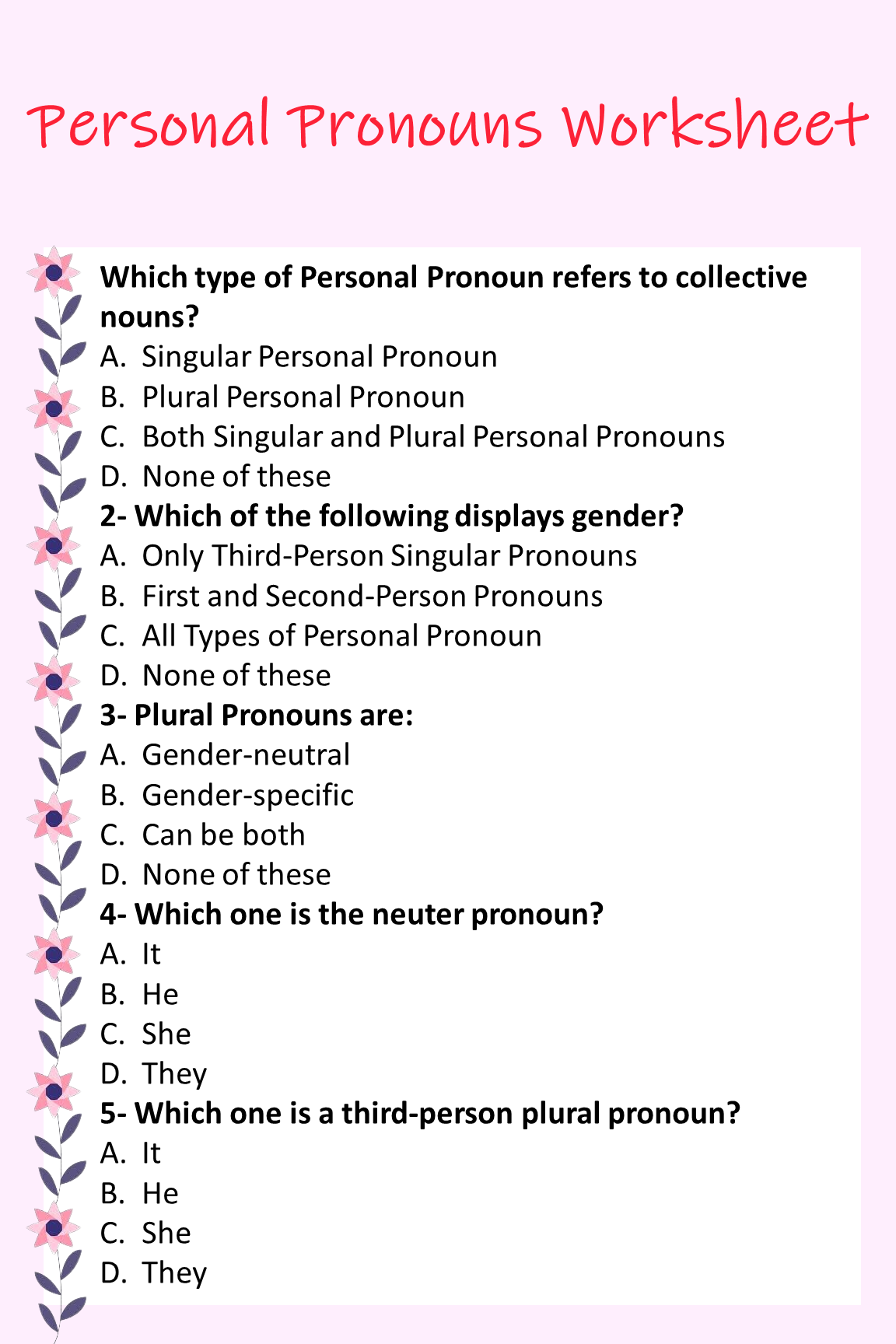
Personal Pronoun Worksheet

